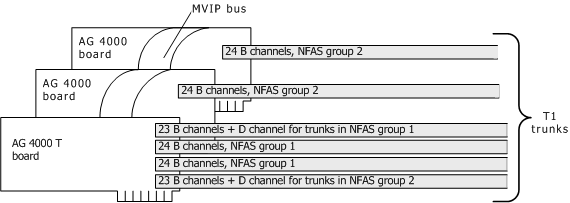
In setups with multiple T1 ISDN trunks, you can set up a single D channel to serve all trunks. This configuration is called non-facility associated signaling (NFAS).
ISDN is transmitted over standard T1 and E1 carriers. T1 and E1 trunks are typically four-wire digital transmission links.
Data on a T1 or E1 trunk is transmitted in channels. For primary rate ISDN, a T1 trunk carries 24 channels. An E1 trunk carries 32 channels. With primary rate ISDN, the channels are usually used as follows:
On a T1 trunk, 23 of the 24 channels carry data: voice, audio, data and/or video signals. These channels are called bearer channels (B channels). On an E1 trunk, 30 of the 32 channels are bearer channels.
On a T1 or E1 trunk, one channel carries signaling for all B channels. This is called the D channel. On T1 trunks, the D channel is typically carried in channel 24. On E1 trunks, channel 16 is used as the D channel.
The following illustration shows an AG 4040 T (standard configuration):

NFAS configurations are supported on T1 trunks only. In an NFAS configuration, trunks are grouped into one or more NFAS groups. One of the trunks in each group has a D channel carrying the signaling for all of the B channels on all of the trunks in the group. This leaves channel 24 free on all other trunks in the NFAS group. This extra channel can be used as another B channel.
The following illustration shows a sample NFAS configuration:

A single NFAS group can contain trunks from multiple boards as shown in the following illustration:

If the application uses NMS ISDN in a channelized configuration, all trunks in an NFAS group must be on the same board. An NFAS group cannot contain trunks from multiple boards. This restriction does not apply to the ACU configuration or the LAPD configuration.